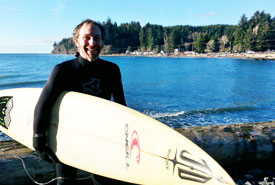Celebrating Canadian species: Bald eagle
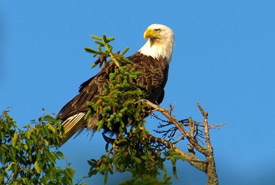
Bald eagle (Photo by Keith Mombour)
It wasn’t the first time I’d seen a bald eagle. It wasn’t even the first time I’d seen a bald eagle that winter, but it was by far the most emotional.
I had recently relocated from Montreal to Victoria, and the constant presence of these majestic birds of prey was taking longer to get used to than I’d expected. After having spent the majority of my life in Montreal, hiking the Appalachian and Laurentian Mountains, I can’t even tell you if there are any bald eagles in Quebec, having never seen one before my move.
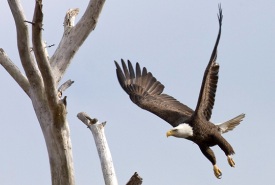
Bald eagle (Photo by Bill Hubick)
On Vancouver Island, however, eagles are everywhere — they float over the highways or above farmer’s fields, and can often be seen casting shadows on the ubiquitous clear cuts that sadly define the coastal rainforests; places where humans have unwittingly made it easier for them to find prey. They exist here even as we chip away at their territory, destroying the very environment that provides spawning habitat for one of their preferred meals: salmon.
Once, just after fall the previous year, having just crawled out of a Cree sweat lodge in Saanich (on unceded WSANEC, or Saanich, territory), I joined in heat-induced elation when the Fire Keeper pointed to a pair of bald eagles circling above the lodge; a deep blessing in the Cree tradition. In some indigenous cultures, eagles are messengers from other worlds, protectors and creatures of peace. Eagles, like all animals, form an aspect of traditional ecological knowledge, which helps people understand their own position within natural systems.
I felt this connection then as I looked up into the darkening evening sky, still flush with sweat, beneath the soaring eagles. Surrounded by a community I was only recently discovering, the eagles helped me find a connection with the place, sky, and people I shared the moment with.
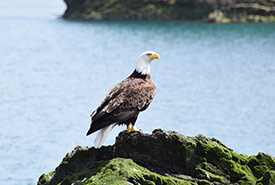
Bald eagle (Photo by NCC)
But even the deep meaning of the sweat lodge eagle experience didn’t compare to the moment I shared with an eagle one winter day early in 2016, when I was alone, surfing at Jordan River, off southern Vancouver Island.
It wasn’t the best day for surfing (thus my being the only one in the water) and I was already contemplating the long, lonely drive back to Victoria, when I noticed a shadow cut across the water. Looking up I saw a bald eagle, circling its way back over land. I relaxed, sitting comfortably on my board in the cold water, no longer afraid. I can’t explain it, and I have no desire to try. I just knew then, under the shadow of an eagle as it eyed the shallows for food, that the terror and the solitude were just as important to the experience as the waves and the rolling green hills.
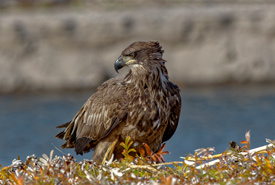
Juvenile bald eagle (Photo by Lorne)
Since then, I’m not as terrified when I surf at Jordan River. In fact, it’s become one of my favorite places on Earth — all because a bald eagle came to comfort me, to tell me whatever it was trying to tell me and to remind me that we are all, in one way or another, just a part of nature.
Get into nature and the holiday spirit by sharing joy and a bald eagle themed tweet below:
The bald eagle is one of nine species featured in NCC’s gift giving campaign: Gifts of Canadian nature. To learn more and to give the gift of conservation this holiday season, click here.

